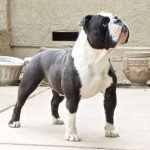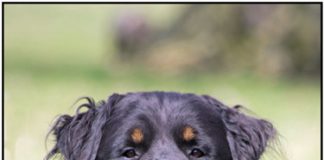
English Bulldogs or simply bulldogs come in a range of colors. The standard colors of these dogs include fawn, fallow, red, white, and brindle. Some of them also come in a combination of two colors, like fawn and brindle and red with white.
But did you know that there is such a thing as a merle bulldog? These types of bulldogs are being rampantly advertised online. Learn more about them in this blog.
What is Merle?
Also known as dapple, merle is a pattern in a dog’s coat that appears due to the presence of the M gene. These patterns, characterized by swirls actually look beautiful and are considered rare in the canine world. However, merle does not occur naturally in all canine breeds. It’s the reason why some merle dogs have become a subject of discussion. It is also not advisable to pair two merles because they will only produce puppies with a number of health problems.
A double-merle or a double-dapple dog is easy to identify because it does not really look like a merle. Instead, it has an entirely white coat and patches across the body and the tail. Bulldogs with this pattern look like a typical bulldog with a compact body and wrinkly coat. But the appearance of their coat looks very different from dogs with the standard color.
In animal genetics, there are three different variants of the merle pattern. In addition to the merle allele, there is also what researchers refer to as the non-merle and the cryptic merle. When a dog has non-merle alleles, it means the patterns are not circled, unlike those with the merle gene. On the other hand, dogs born with the cryptic merle allele means their patterns are very light that they are not too visible at all.
Is Merle Accepted in Bulldogs?
Merle is not among the accepted markings of bulldogs. It is an accepted pattern in several breeds like Border Collies and Pyrenean Shepherds, but this is not the case with English bulldogs. A merle bulldog is not a purebred but likely a cross with another breed because this pattern is impossible to occur just by pairing two purebred bulldogs. The only allowed markings for this breed, as per American Kennel Club, are the following:
Piebald – these are bulldogs with a solid color but have patches either on the body or on the head. These patches are usually confined to these areas, unlike merle that can appear anywhere. It appears in a number of breeds and occurs because of the presence of the recessive gene. Piebald bulldogs usually have a white coat and come in red or fawn patches on the eye area.
Brindle – this is characterized by patterns that look like tiger stripes. In bulldogs, it usually appears as red with some white markings. During ancient times, most bulldogs were actually seen in brindle colors. It does not come as a surprise, since the bulldog is a descendant of terriers and brindle bulldogs.
Ticked – you might have stumbled upon bulldogs with flecks or spots across the body. In bulldogs, ticking is very light and it is not as distinct as the ones we see in gundogs. The flecks can be seen on the legs, although some can have it on the muzzle area. Do note, however, that it is also possible for merle dogs to have ticking.
White marks – these white marks may appear anywhere across the body. They may also come in various sizes, some being small while others are larger. In many English bulldogs, these marks can be seen from the ears all the way down to the chest.
Black mask – just like what the name suggests, the dog looks like he’s wearing a mask. The right term for this is melanistic mask and it actually appears in a number of breeds. The mask usually appears on bulldogs in lighter shades like fawn and fallow, which is a pale shade of brown.
Black tips – black is one of the undesirable colors among English bulldogs, but that does not mean they cannot come with black tips. Bulldogs with black tips should not be disqualified because they still conform to breed standards.
Based on the breed standard set for English bulldogs, any coat color and markings other than the accepted ones, are considered a disqualification. This means the dog may not be eligible for conformation competitions but will only be allowed to participate in companion events or performance events set by the AKC.
DNA testing is actually relevant in all dog breeds, including English Bulldogs. Genetic testing can be done to confirm if a dog is carrying one copy or two copies of the M allele. If you have an English bulldog and you suspect it carries the merle gene, you may submit his blood sample to an animal testing center. You can get the results in a matter of days.
Appearance
Dogs with merle patterns look like they have dark pigments in many areas of the body. Merle bulldogs may come in two or three color combinations. Certain areas of the coat look like they are in a diluted color or lighter color. For instance, a blue merle bulldog looks like a blue dog with grey patches across the body. It also has blue-colored eyes.
M-locus is responsible for creating patches of color in a solid coat. It can also produce changes in the color of the dog’s eyes. Bulldogs with merle genes may also have differently colored paw pads and nose. Instead of the usual black color, you will see them having pink noses. However, it’s worth noting that not all merles will have a pink nose. It’s also possible to see them with dark eye color although some dogs may have blue eyes.
Health
Health problems are more likely to arise if the dog is carrying double copies of the M allele. This is why it is important to do DNA testing to see if a bulldog is carrying two copies of the merle gene. If you own or you are interested in owning a merle bulldog, here are the health concerns you need to be aware of:
Deafness – double-merle dogs often suffer from impaired hearing and this is because of the presence of M allele. Coat color-related deafness may start at birth. A dog may be partially deaf or only have hearing impairment in one ear or can be completely deaf, meaning that both ears can suffer from hearing loss. However, it does not mean that all double-merles are automatically deaf. Consider having a dog tested to confirm if it’s subject to deafness or not.
Vision problems – studies suggest that dogs with merle coloring may also suffer from eye anomaly. The conditions may vary. In some pets, the problem is the thinning of the iris while in others it could be having an off-center pupil. Another condition an affected dog may have is iris coloboma. This is a condition wherein the iris did not develop normally. The result is a cleft-like appearance on the edge of the pupil.
Other than these conditions, there is no more problem associated with this breed. A double merle dog will still have the same intelligence and traits common in bulldogs. In fact, many dogs with this condition capture the hearts of the people they meet because of their abilities and intelligence. These dogs can still live a perfectly normal life despite their condition.
Important Reminders Before Owning a Merle Bulldog
It’s tempting to buy a merle bulldog because of its extraordinary appearance. However, anyone who would like to have one for a pet should remember that a good breeder will not condone the breeding of dogs that are not following the breed standard.
This does not mean that merle bulldogs do not have the right to be loved and cared for. But if you are really decided to have one, it’s a better idea to adopt rather than shop. This way, you are helping these dogs have a second chance at life. You can find some of these dogs in animal shelters, because they are often neglected by their owners who were not prepared for the health problems associated with these pets.
Bulldogs themselves are already subject to a number of health problems. It’s the reason why they have a short lifespan. Introducing the merle gene will only make things worse. It makes them more prone to conditions like deafness and visual abnormalities. Part of owning a merle bulldog is being prepared to deal with these conditions.
Conclusion
A merle bulldog looks like an exotic version of the English bulldog. It looks extraordinary but it actually comes with a number of health problems like deafness and eye anomaly. If you are interested in breeding merles, you need to provide special care and attention because of the health concerns associated with them. If you are thinking of owning one, better do your research first before making a final decision. Owning a dog is a big commitment so better think of it first before considering a merle dog as a pet.





















